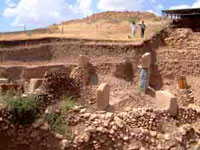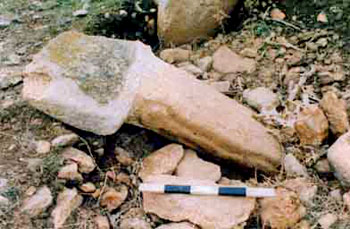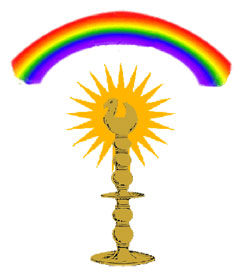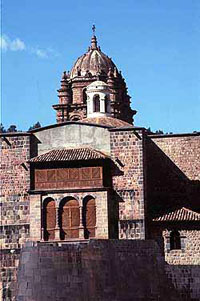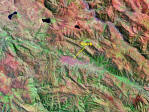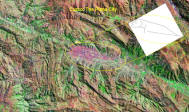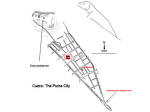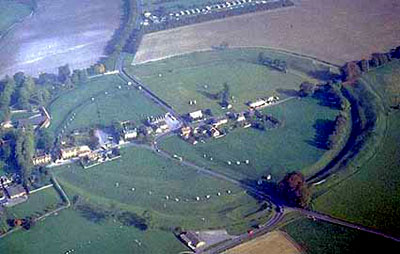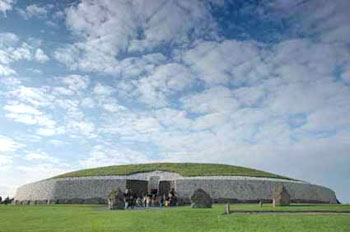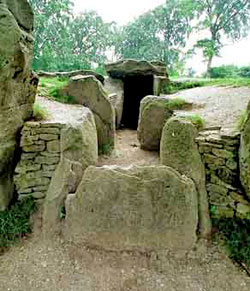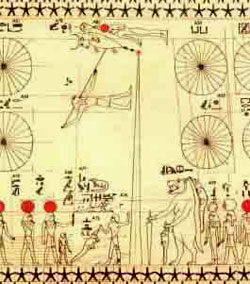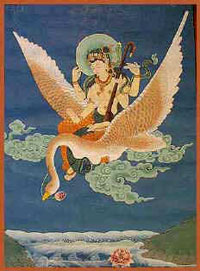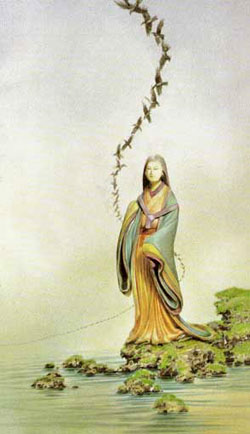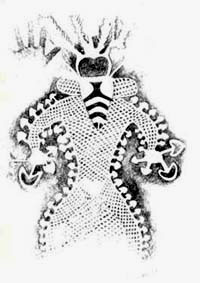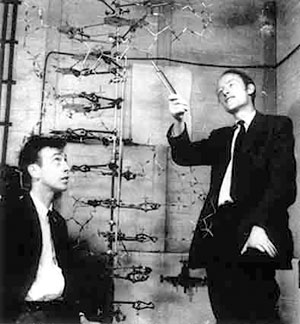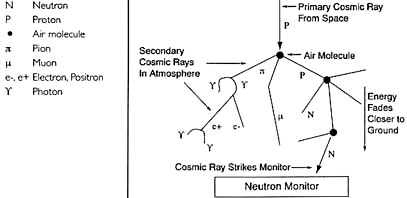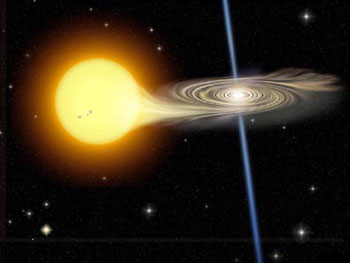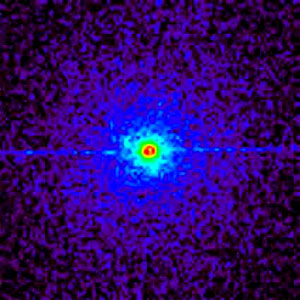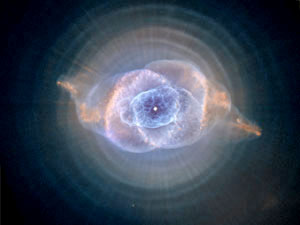|
|
|
by Andrew Collins from AndrewCollins Website
According to the German archaeologists who have been excavating here since 1995, Göbekli Tepe, as much as 11,500 years old, was constructed by faceless individuals (+/- 500 years) belonging to an epoch known as the Pre-Pottery Neolithic.
This was a transitional stage between
the hunter gatherers of the still present Ice Age, and the more
settled agricultural communities that emerged on the banks of the
Euphrates river shortly after the ice sheets receded, causing a
gradual change in temperature and environment.
Might they be aligned to the stars like megalithic monuments worldwide?
Gobekli Tepe
Exactly what the mindset was behind those who created Early Neolithic sites such as Göbekli Tepe and Karahan Tepe is a complete mystery.
Who were these faceless individuals, and what inspired them to construct such incredible monuments at the end of the Last Ice Age?
Note similarity of the structure of the sperm to the carving on the stone above
Other stone structures in South-east Turkey from a slightly later age, such as Çayonu north of the city of Diyarbakir and the now submerged site of Nevali Çori in Hilvan province, between Diyabakir and Sanliurfa, also have their ritual areas at the northern ends. This preference for the north is found among the Sabians, a pagan race who thrived for thousands of years at the nearby city of Harran.
They envisaged the Primal Cause, God himself, as a divine force that resided in the north. This was their kiblah, or direction of prayer, while Sabian feasts honouring the Mystery of the North regularly took place.
Was it possible that the Sabian form of worship was a leftover from a much earlier epoch, when the earliest Neolithic temples were built in the same region?
Yezidi sanjak depicting cosmic bird atop the sky-pole.
Several other early cultures, religions and civilizations connected the north not only with the direction of the celestial abode, but also with the transmigration of the soul.
Among them were the Mandaeans of Iraq and Iran (first encountered by European travellers during the Middle Ages and erroneously termed 'St John's Christians'), the angel-worshipping Yezidi from Northern Iraq and Syria, and the Shiite sect known as the Brethren of Purity, all of which are descended from the Sabians of Harran.
Most usually it is
the Pole Star, also known as the North Star, that is the object of
their veneration, even though originally this could not have been
Polaris, the current Pole Star, due to the process of precession.
It is depicted on the walls of Çatal
Huyuk, the oldest known city in the world, built on the Konya plain
in Southern Turkey, c. 6500 BC, by the descendants of those
responsible for sites such as Göbekli Tepe and Karahan Tepe in
Southeast Turkey. At Çatal Huyuk we see the vulture carrying, or
accompanying, the soul of the deceased, shown as a head, into the
afterlife.
Had this been a celestial object of veneration among the Early Neolithic peoples of South-east Turkey, even after it ceased being Pole Star?
Although an attractive
proposition it made no sense of alignments at the Neolithic sites
examined, so another explanation was sought using a computer
generated map of the night sky.
Moreover, on its lower transit of the meridian - the north-south zenith line that bisects the night sky - it crossed from left to right just above the northern horizon.
Cygnus was identified as a celestial bird on the Euphrates as early as c. 2000 BC.
Although most obviously a swan in Europe, Cygnus had, like Lyra, once been seen as a vulture, making it an obvious destination for those human souls being accompanied into the afterlife by a psychopomp (Greek for 'soul carrier') in the guise of the celestial vulture.
In pre-Islamic Arabic tradition, Cygnus
was the Eagle of the Arabs, a mythical bird known also as the roc,
or rukh. This was venerated by the Yezidi, the angel-worshipping
descendants of the Sabians of Harran, as a form of Khuda (Kurdish
for 'God '), associated with the Mysteries of the North.
These idols have been identified
variously with Allah and/or al-Lat, al-Uzza and
Manat, three
pre-Islamic goddesses associated with the swan, or crane. Their
avian associations link them directly with Cygnus, which as the
celestial swan came under the influence of Near Eastern love
goddesses, who in Classical tradition were identified as Aphrodite
and Venus.
Moreover, the dove as a Christian symbol of the Holy Spirit (Greek
pneuma), derives from the Hebrew concept of the Spirit or Breath of
God (ruach), and stems from the same cosmological root as the Yezidi
concept of the anfar, the form of Khuda (God ) as a bird that brought
the universe into manifestation. In the first chapter of Genesis the
Spirit of God (ruach) hovers over the primordial waters moments
before God's Creation of the universe. The dove or pigeon was
equated with Cygnus in Arabic tradition.
In shamanic tradition worldwide, this
World Tree had to be ascended to reach the celestial abode, or
sky-world, either via the Milky Way or the north-south meridian
line. It was a realm accessed via a hole, door or gate at its most
northerly point, and often this was seen as being located someone in
the proximity of the cosmic axis, marked by the bird at the top of
the tree, which we can safely identify as the Cygnus constellation.
If deemed pure enough, the soul then makes its onward
journey by boat over a celestial 'river', arguably the Milky Way, to
one of the countless 'worlds of light', inhabited by their dead
kinsmen. In these unimaginable realms, governed by 'great spirits of
light', they meet other purified souls as well as their own 'dmutha
or over-soul '.
From here in 9500-9000 BC, the Milky Way emerged from the horizon and rose almost horizontally until it reached the stars of Cygnus which would have hung just above the northern horizon.
The answer appears to lie in the fact that between c. 16,000-15,000 BC Deneb was Pole Star.
At the same time, the Milky Way would have risen up from the
eastern horizon to where Cygnus occupied pole position, whilst the
stars of Scorpio, anciently seen as a serpent, were placed at the
base of the Milky Way expressed as the World Tree.
The Early Neolithic sites
in South-east Turkey as well as ancient cosmologies worldwide
suggest that this was indeed the case. Yet how universal were these
concepts, really? Only by tracing the roots of this apparently Palaeolithic ideology could the theory really be proved.
They, having arrived on the
continent from Asia in Late Palaeolithic times and, in theory,
having remained in isolation through until the time of the conquest,
might well have preserved some semblance of knowledge regarding the
former significance of Cygnus to the prehistoric mindset, imported
on to the continent by nomadic peoples using the Bering land bridge
between Siberia and Alaska, which emerged as the ice sheets withdrew
at the end of the last Ice Age, c. 10,500-9500 BC.
It forms part of a foundation story that is arguably Palaeolithic in origin, and might easily have crossed over to North America from the Eurasian continent more than 11,500 years ago.
A number of other tribes preserve similar traditions about the Milky Way, seen as a celestial road or river to the sky-world. More significantly, some tribes, such as the Skidi Pawnee, single out the sky-world as a Star of the North, often confused with Polaris, the current Pole Star, which is nowhere near the Milky Way.
This northerly-placed star is associated
by the Skidi Pawnee and others, with a constellation known as the
Bird Foot, or Turkey Foot, a three-pronged device identified as
Cygnus, making Deneb the most likely candidate for the Star of the
North. Such knowledge is confirmation that ancient star-lore of this
nature might well date back to when Deneb was Pole Star. It also
strengthens the case for such ideas being inherited by the Early
Neolithic peoples from their Palaeolithic ancestors.
The henge monument's single entrance faces the point on the horizon where the midsummer sunrise occurs, and after surveying the site we find that it was constructed so that anyone watching from Eagle Mound prior to sunrise on the summer solstice would have seen the Milky Way rising up into the sky from between the site's entrance.
If the celestial trial was followed
upwards it would take the observer to where the stars of Cygnus were
to be seen directly overhead, imitating the position of Eagle Mound.
The
purpose of the midsummer alignment was most probably to enable the
living and the dead to access the sky-world via the Milky Way as the
celestial road or river of the soul.
The
symbol in Mayan texts used to represent Cygnus she has identified as
the cross bands glyph, which appears also on much earlier Olmec
statues of the were-jaguar. This, she suspects, signifies the starry
sky.
It features also as the beautiful bird Seven Macaw, who sits
atop the World Tree in Maya tradition. This can easily be
interpreted as the Milky Way, as is shown by American academics
David Freidel, Linda Schele and Joy Parker in their fabulous work
Maya Cosmos: Three Thousand Years on the Shaman's Path, published in
1993.
The sun will emerge at this time at a point that aligns with the visual position of galactic centre, something which some modern researchers feel the Maya were aware of somehow. In ancient Mexican cosmology, the sun was seen as an egg that comes from a crack which opens in a cosmic mountain, and this can be equated with the Milky Way's Great Rift, the dark region caused by interstellar dust clouds where new stars are born.
This begins at Cygnus and continues on
down to Sagittarius and Scorpio, where it opens out to form the
point of emergence of the new sun.
This is despite the fact that Peru is in the Southern Hemisphere, and the northern celestial pole would not have been visible. At Cuzco, the administrative capital of the Inca Empire, the rebirth of the sun was celebrated at the time of the winter solstice (the summer solstice of the Northern Hemisphere). Here was to be found the sacred river known as the Vilcanota, seen as a terrestrial representation of the Milky Way.
All along the river valley are topographical features such as settlements, terraces and even cities built on prominent natural features that the Incas felt were terrestrial effigies reflecting the influence of star-to-star and dark cloud constellations located along the Milky Way.
Cuzco was seen by the Incas as the centre of the world, the axis mundi, linked to the sky-world via points of access on the Milky Way when it rose up from the horizon at the time of the solstices (just like at Newark's Great Circle).
St Domingo church, Cuzco, built on the site of the Coricancha.
Cuzco's own terrestrial personification is that of a puma, the symbol of kay pacha, 'this world'. Its head and jagged teeth are to be seen at Sacsahuaman - the hilltop fortress famous for its foundation walls composed of breathtaking cyclopean masonry.
The town's main plaza of Huacaypata corresponds with the feline's belly and legs, while the Coricancha, site of the former temple of the sun on which was built the church of St Domingo, falls in the vicinity of its genitals.
The spine and tail of the puma are represented by the Tullumayu and Huatanay rivers, which flow into the Vilcanota river.
Italian astrophysicist Giulio Magli, Professor of Mathematical Physics at Milan's Politechnic, has identified Cuzco's celestial puma as a joint star-to-star and dark cloud constellation occupying the position of Cygnus at the very top of the Great Rift, demonstrating that this was the Incan point of access into the celestial abode, called hanaq pacha, the 'world above'.
It was here that the human
soul started its life and would ultimately return in death. This was
accessed, or linked, via its terrestrial counterpart focused upon Cuzco, the Incan centre of the world, making this place an
expression of Cygnus laid out on the landscape.
Constructed c. 2600-2000 BC, it consists of a circular henge and ditch that appear uncannily like those making up Newark's Great Circle. Yet unlike its American counterpart, Avebury has a gigantic circle of standing stones inside the henge, with another pair of circles contained inside the larger one.
Approaching the great circular earthwork from a distance of around 2.5 kilometers (1.5 miles) were once two giant avenues of stones, of which only fragments of one remain today (the Kennet Avenue).
Aubrey Burl, a leading authority on megalithic structures in Britain, has outlined his belief that Avebury was the centre for a regional cult of the dead and rebirth.
Overhead photo of Avebury.
Avebury was surveyed during the eighteenth century by antiquarian William Stukeley, who saw the whole monument in terms of a winding serpent (the avenues) curling around a sun disk (the main henge and circles).
For him it was a personification of Kneph, a Graeco-Egyptian
creator god (also known as Chnoubis, or Khnum) which he acknowledged
was linked in classical mysteries with the story of 'Cycnus', a
character of legend personified in the sky as the Cygnus
constellation.
In the knowledge that the water-filled meadows
of nearby Silbury Hill, as well as the Kennet river which runs
alongside Avebury, once played host each winter to flocks of
migrating whooper swans inbound from their breeding grounds in the
Arctic, this had to relate in some way to Avebury's axial alignment
towards the setting of Deneb.
Her cult
lingered through until Romano-British times, most obviously as the
divine patron of the Brigantes, the powerful northern tribe famously
led at the time of the Roman conquest by the warrior queen Cartamandua.
This same symbol was associated by Welsh
bards and druids with the goddess Minerva, the given to the Gallic
form of Brigantia, or Brigid, by the Romans. Yet what might any of
this have to do with Avebury's cult of the dead?
Cygnus being essentially circumpolar in Scotland would always have been seen in the northern night sky. Is this how the stars of Cygnus became associated with the swan, and why the bird was linked with not only the cosmic axis, but also the journey of the soul into the afterlife - because it was seen to fly towards the celestial pole?
If so, then this connection can only have begun when Deneb occupied the position of Pole Star in c. 15,000 BC.
Swans in flight
Among the peoples of the Baltic the swan replaced the stork as the bringer of new-born babies, showing that it both brought life and took it away again.
This process of giving and taking life is
exemplified at Çatal Huyuk in Southern-central Turkey where
Neolithic wall sculptures contain vulture's skulls inserted
horizontally so that the tips become the nipples of sculpted
breasts, while murals nearby show human foetuses inside the bodies
of vultures.
It comes in the form of a series of
earthen pits unearthed at Saveock, Cornwall, and found to contain
carcasses of swans, as well as other votive offerings such as eggs,
down feathers, crystals and stones. It is important to recall that
at this time England was under Puritan rule, with the punishment for
any kind of sympathetic folk magic being very severe indeed.
Yet her worship proved to
be only half the story, for a whole different cult of the swan once
surrounded the return of the birds each November, a fact echoed in
an archaic ceremony that continues each year on the River Thames.
For over 600 years, two ancient livery companies of London - the Vintners and Dyers - have accompanied the British sovereign's swan-master and swan-warden on an enchanting journey along the River Thames from London to Oxford. Its purpose is to mark and weigh all cygnets - young swans - allotted by birth-right to one or other of the companies.
Great pomp and ceremony surrounds
Swan-upping, as the event is known, which takes place in the third
week of July (previously in association with a swan feast on St
Swithin's Day, 15 July). What is more, the Vintners - the wine
traders - have a whole room celebrating Swan-upping at Vintners'
Hall, their home close to the River Thames in the City of London.
Swan Upping on the Thames
Moreover, there is some evidence that the Vintners Company, derived
from a 'mystery', or guild, of Saxon origin, was linked originally
to the city's Roman Temple of Isis, which lay within 300 meters of
Vintry Wharf, where the Swan-upping ceremony traditionally began.
Although this tradition
continues, today the Vintners eat a goose at Martinmas, while
instead of a roast swan being paraded around its place is taken by a
stuffed bird. When not in use, it is kept in the Swan Room at
Vintners' Hall.
It was around this time that migrating
swans (and geese) returned from the Arctic, most usually at night
under a full moon. Whooper swans in particular make unearthly sounds
in flight that might once have been taken as the dead returning to
this world, the origin perhaps of the association between Hallowe'en
and the skies being alive with witches, spirits and other
supernatural specters at this time (old pictures exist showing
witches riding geese in particular).
Such information provides us with some understanding of the annual rituals that once might have taken place at prehistoric Avebury, which becomes Britain's premier site for the cult of the swan.
Yet it is across the Irish Sea in Ireland that we
find what is arguably the British Isles' most significant link
between Cygnus and the Neolithic world.
In it's an enchanting spectacle that befits its former identity as a sidhe, a house or palace, of the Tuatha de Danaan, the mythical first inhabitants of Ireland. In this guise it features in the old Irish tale known as 'The Dream of Angus', concerning a chieftain named Angus Mac Og, whose story relates how he fell in love with a swan-maiden after she visited him in a dream.
After she agreed to marry him, they fly off to Newgrange
in the form of swans, where they lived happily ever after. In
Scottish folklore, Angus was married to the goddess Bride, who was
herself a swan-maiden.
Sensing that this annual spectacle might have influenced the mythology and practices of those who built the Newgrange monument, they wondered whether the passage grave reflected the influence not just of the sun, but also that of Cygnus, the celestial swan.
Newgrange passage grave.
Overlaying the stars on a map of Newgrange, they determined that the monument's interior echoes the arrangement of Cygnus's principal stars (see their site mythicalireland.com). Moreover, if the midwinter sunrise line is extended backwards some 15 kilometers (9 miles), it targets a smaller passage grave known as Fourknocks.
This they found to be aligned perfectly
to the rising of Deneb in c. 3000 BC. Thus the solsticial sun has to
pass through a Deneb aligned site before reaching Newgrange, which
is itself a terrestrial form of the swan, reflected in 'The Dream of
Angus'.
Such stories are linked also with the European tradition of 'Le Chevalier du Cygne ('Knight of the Swan'), descended of a swan-maiden M, creating the archaic belief that certain families and individuals were descended from a mythical swan-knight.
These includes the Cleves family, from
whom came Annes of Cleves, wife and queen of the English king
Henry
VIII, and Godfrei de Bouillon, the leader of the First Crusade.
A young woman was found beneath a small
knoll, next to her dead child, who had been laid to rest on a swan's
wing. Its striking presence has been seen by some archaeologists as
evidence of a link between the swan and the transmigration of the
soul. If correct it shows the antiquity of this cult, which preceded
even the spread of Europe's megalithic culture, of which both Avebury and
Newgrange are prime examples.
They were female spirits, shape-shifting swan-maidens, who carried the souls of the dead to Valhalla, the Hall of the Heroes in Norse myth.
Although Wayland's link with the monument that bears his name post-dates its construction by some 4,000 years, it cannot be coincidence that, quite separately, prehistorian Professor John North determined that Wayland Smithy is aligned to Deneb, suggesting that a swan cult existed here as early as c. 3700 BC, its accepted date of construction.
Wayland Smithy long barrow.
From Wayland Smithy we travel to the Scottish Outer Hebrides, where at Callanish on the Isle of Lewis, we find one of the most impressive stone circles in Britain.
Legends speak of it being built
by a black-skinned people who arrived in the company of a white
priest-king dressed in a coat of mallard feathers, which along with
swan feathers was the traditional garment of a Gaelic bard.
This would have been a magical sight to anyone present, and so makes sense of why the stone avenue was built to mark this remarkable phenomenon.
Aubrey Burl argues that Callanish's foundation story associates it with a rebirth cult linked with water and waterfowl. It is a conclusion that adds weight to Callanish's proposed Cygnus alignment, which must now be seen as part of a more widespread religion that embraced the megalithic world with its own unique religious practices associated with cosmic life and death.
Yet having established the reality of
the cult in megalithic Britain, we now go in search of the Cygnus
mystery to Egypt, where we come a little closer to understanding the
constellation's greater purpose in the minds of our most distant
ancestors.
Invariably, Egyptian funerary monuments were aligned north-south, a
ritual act achieved with precision in the Pyramid Age. Finding true
north was ceremonially determined during a ritual known as
'Stretching of the Cord', which involved the use of a specific star,
or stars, in the northern night sky.
These were Cygnus and Ursa Major, which he identified as asterisms known in Ancient Egyptian astronomy as, respectively, dwn-'nwy, a falcon-headed god, and mhtyw the bull, or ox thigh, additionally seen as the old foes Horus and Set, ever sparring around each other in the night sky.
Zába's findings were
subsequently verified by Livio Catullus Stecchini (1913-1979), the
brilliant Italian mathematician and metrologist.
This linked the axis mundi, 'axis of the earth', with the cosmic axis, i.e. the northern celestial pole, providing us with a purpose for the northerly orientation of almost all pyramids and many more simple, so-called 'mastaba' tombs as well.
The Northern Group of constellations
including the falcon-headed god dwn-'nwy identified as Cygnus.
Even though Thuban in Ursa Minor was Pole Star at the beginning of the Pyramid Age, after it had shifted too far to be classified under this title, the stars of Cygnus and Ursa Major would seem to have been used to mark out the line of cosmic ascension.
This concept was
also displayed on the ground. Some 17 kilometers (10.5 miles) due
north of Giza is Ausim, the site of the ancient city of Letopolis.
This was once the home of the priest of the sacred adze, used in the
Opening of the Mouth ritual, which enabled the pharaoh to speak in
the next world.
Yet if this was so, was there somewhere on this
meridian line that represented the falcon-headed god identified with the stars of Cygnus?
The pharaoh's final journey into the
afterlife was periodically enacted during a fabulous festival of Sokar, which included his symbolic death and rebirth in the
afterlife. Sokar presided over the Memphite necropolis, which
included Giza, ancient Rostau, and since he can be equated with the
falcon-headed god of the Northern Group of constellations, which can
be identified as Cygnus, then Sokar's role in Egypt sky-religion is
vital.
Moreover, the presence there of intact jars from the even older Maadi-Buto culture argues for the presence here of a funerary cult as early as 3900-3200 BC, while the discovery to the south of the plateau of even earlier chert tools from the Neolithic age is tentative evidence that Giza was active from at least 5000-4000 BC.
Sokar from the tomb of Thutmose III.
As ancient Rostau (which translates as 'mouth of the passages'), Giza was associated with the most secret part of the perceived underworld through which the soul of the deceased was expected to pass in order to achieve ascension under the guardianship of Sokar.
Rostau was intrinsically linked with the Mound of Creation in
ancient texts, signifying that the Ancient Egyptians saw Giza as an
axis mundi of the physical world.
All vied for superiority as early Old
Kingdom times, and yet there can be little question that the
funerary cult most associated with Giza at the beginning of the
Pyramid Age revolved saw ascension as accessible via the north-south
meridian line marked, as in Olmec tradition, by the stars of Cygnus
and Ursa Major.
The connection was precise, even more so that if one were to
do the same with the stars of Orion, previously linked with the
ancient astronomy of the Pyramid Age.
In addition to
this, the orientation of the three pyramids matches the setting of
Cygnus on the north-western alignment during the same epoch.
What is more, Deneb, we find, might easily have been employed, symbolically at
least, in the Stretching of the Cord foundation ceremony, known to
have been used to orient buildings including pyramids such as the
ones at Giza.
It lays the sun-egg from which
the creator god emerges, his name altering depending on which cult
centre the myth is attached.
This indicates that the Ancient
Egyptians saw the point of creation as located in the vicinity of
Cygnus. In addition to this, the Great Cackler was a totem of Geb,
the earth god, whose wife/lover was Nut, the sky-goddess.
Occasionally, the Great Cackler is shown at the feet of Nut as she
is prised apart from Geb in order to form the sky and earth.
Yet this legend is most certainly a corruption of a far older belief in sacred texts found on the walls of the Graeco-Egyptian temple at Edfu in Southern Egypt, and brought to the world in 1969 with the publication of Egyptologist Eve A E Reymond's wonderful book THE MYTHICAL ORIGIN OF THE EGYPTIAN TEMPLE.
They speak of a subterranean domain,
called the Underworld of the Soul, accessed via a well-shaft, which
once existed in the vicinity of Giza. Mythical beings, known as the
Primeval Ones, led by an individual called the Falcon conducted
entered this chthonic realm to embrace its divine radiance known
variously as the Embryo, Seed , Lotus, or Sound Eye.
On the aforementioned Giza-Cygnus overlay this rocky
outcrop is marked by Albireo, the star signifying the mouth or beak
of the cosmic bird in Arabian star lore, recalling Giza's name of
Rostau, meaning 'mouth of the passages'.
According to prehistorian and philosopher Mircea Eliade, this was a magico-religious belief of shamanic origin that pre-dated Dynastic Egypt. Arguably, it went back beyond the Neolithic era to the Palaeolithic epoch when Deneb and the stars of Cygnus occupied pole position. Yet where else could this same shamanic root be traced?
We journey next to India in
search of further clues.
The main temple is dedicated to Brahma, the creator god. He is said to have emerged from a cosmic egg laid by Hamsa, the swan-goose, responsible, like Ancient Egypt's Great Cackler, for creating the divine sound that brought the universe into being.
Brahma rides on a sky-car pulled by
seven swans, while the swan-goose is also the avatar of his wife
Saraswati, the goddess of music, writing and divine inspiration. She
is the personification of what was once India's most sacred river,
the Saraswati, which rose in the foothills of the Himalayas in
southwest Tibet. Just like the Ganges today, it was seen as a
terrestrial representation of the Milky Way, linking Saraswati with
Egypt's sky-goddess, Nut.
They are known to have been a shamanic based society,
which almost certainly used trance states, and Soma, the drug of
enlightenment, to obtain otherworldly information. This might have
included the writing of the Vedas, as well as knowledge of Kalahamsa,
the Swan-Goose of Eternity, the form of Brahma who brought the
universe into manifestation.
Yet exactly how old was this belief?
To help answer this question, we move now to China where we discover an ancient astronomy 17,000 years old.
Saraswati on her swan vehicle.
Thereafter the lovers were allowed to come together just
once a year, at which time every magpie in the land would fly to
heaven in order to create the so-called Magpie Bridge, formed across
the Milky Way by the stars of Cygnus. Both Schlegel and Staal felt
this story dated back to the time when Vega took over as Pole Star
from delta Cygni in Cygnus around 15,000 years ago.
The bird on a stick is the most
interesting feature, for it is very likely a symbol of the sky-pole,
or cosmic axis, with Cygnus as the bird on top. Furthermore, it
demonstrates that this universal concept dates back to this age, and
might easily have influenced the development of magico-religious
ideals through until the beginning of the Neolithic age and beyond.
For instance, my own studies into the religious beliefs and practices of the Dogon tribe of Mali in West Africa show that it was not Sirius that they saw as the source of life, as some modern writers have speculated, but Cygnus, and more significantly Cygnus in the manner that it appeared in the night sky some 17,000 years ago.
The Weaver Princess standing on the edge of the Milky Way
with the
Bridge of Magpies (Cygnus) behind her.
Yet how did Palaeolithic peoples some 17,000 years ago come to
believe that Cygnus was the point of creation, and the destination
of the soul in death?
It shows also expressions of their
hallucinatory visions, which include everything from abstract
geometric forms to chimeras (purely animal hybrids), therianthropes
(human-animal hybrids), and other types of perceived spirit
intelligences. What is more, there is every reason to suppose that
these encounters were initiated by the oral ingestion of psychedelic
plants and/or mycetes, i.e. psychoactive mushrooms.
It is from this region of the
Sahara that
the Dogon tribe are thought to have come prior to their
southerly migration to more fertile regions on the River Niger in
what is today Mali.
Could this be the origin of some sort of death cult, whereby the initiate was brought very close to physical death in order that they might experience the otherworld, the place of the afterlife?
Rock art from the Tassili mountains of Algeria
showing a therianthorpe with mushrooms in his hands and around his body.
As already shown, the Early Neolithic peoples of South-east Turkey practiced their own death cult, symbolized by the vulture, seen most likely as a personification of Cygnus as the celestial bird atop the cosmic axis.
Thus it is no surprise to find that there are various
examples of symbolic art showing mushrooms in association with key
shamanic symbols such as the vulture, serpent and egg at the
Pre-Pottery Neolithic sites of Southeast Turkey.
He put his career on the line in 1970 when he published details of widespread philological evidence of a mushroom-based cult of creation encoded within the Sumerian and Akkadian languages.
Their joint civilization, arguably the oldest anywhere in the world, sprang from the Early Neolithic culture responsible for sites such as Göbekli Tepe and Karahan Tepe. Allegro associated this mushroom cult directly with the symbol of the swan (and the stork), which he saw as a representation of the female reproductive parts.
Even though he only recognized the
origins of this cult as going back to 4000 BC, it can be traced back
to Palaeolithic times, with the most common themes cosmic life and
death.
They told him it was given directly to the ayahuasqueros, the drinkers of ayahuasca (a powerful psychedelic brew, with the active ingredient DMT) by the spirits of the plants. He did not believe a word of it until he was cured of severe backache simply by ingesting a prescribed natural brew.
So he agreed, finally, to try ayahuasca
for himself. This resulted in a psychedelic experience in which he
saw twin snakes, giant boas, which he felt were objectively real and
very important for some reason.
Such ideas are made possible through an understanding of signal nonlocality on a quantum level, and since compelling evidence now exists for life having evolved in interstellar clouds - the concept of panspermia - might Narby's theory be extended to include biological life elsewhere in the galaxy?
Could this provide some answers as to why Cygnus was seen as important by our most ancient ancestors?
Francis Crick (right) with his model of the DNA double helix.
Francis Crick, the Nobel-prize winning discoverer of the structure of DNA, heavily supported the concept of what he called Direct Panspermia, in which he proposed that life on earth was deliberately seeded by an advanced civilization, a concept first intimated in the writings of Anaxagoras, a Greek philosopher who thrived c. 450 BC, and now being confirmed for the first time by science.
Thus it is interesting to note that
Crick admitted secretly not only to taking small quantities of LSD,
but also to first seeing the famous DNA double helix structure when
high on the drug. If so, then were shamanic journeys during Palaeolithic times, where the initiate would journey to the stars
using the sky-rope, vine or ladder, reflective in some way of his
belief that life originated elsewhere, and that after death we would
return from whence we came?
Earlier we saw how the Mandaeans of Iraq and Iran believed
that the human soul passed beyond the North Star, identified here as
Deneb in Cygnus, where it would join a sky-boat that would take it
across the celestial river, arguably the Milky Way, to one of the
countless 'worlds of light', home to their dead kinsmen. In these
blissful realms, governed by 'great spirits of light', they would
encounter their purified souls as well as their own 'dmutha or
over-soul'.
He compared
this native concept with those of the seminomadic Naskapi of
Labrador in Canada, who 'speak of the possibility of contact between
worlds along the Milky Way, which they call "ghost trail," or "dead
person's path."'
Similar ideas on the
transmigration of the soul lay at the heart of almost all ancient
religions, such as that of Dynastic Egypt, inspiring the belief in a
celestial heaven, somewhere that was accessible not just to spirits
or souls of the dead, but also
shamans who, as we have seen,
believed that they could enter the sky-world via a 'hole', door or
gate beyond the northerly placed cosmic axis.
In Formasa (modern Taiwan), the Tsalisen
say that their ancestors came out of the moon, while the Kayan and
Kenyah say that sky-beings made the first man and woman in the form
of stone images. The Totemboan say that To'ar, a 'sun-lord', married
their daughter Lintjambene, while her son Si Marendor was said to
have been half sky-born and half made of stone.
Beyond this is the view shared by
ancient peoples all over the world that even though we might have
been born on earth, and are the descendants of the first human
couple, our true self, our soul, originates elsewhere, and upon its
release at death it will be free to return from whence it came. This
recalls the magico-religious beliefs of the shamanic-based societies
of Asia who considered that the souls of children sat in the upper
branches of the World Tree where they await a shaman to draw them
into incarnation, or even the European folk belief in storks, or
swans, bringing new born babies into the world.
Many other examples might be cited, such as the Native American
peoples who point towards a star and say it is their original
homeland, or the African tribes, including the Dogon of Mali that
likewise claim to be descendants of sky-beings.
So did these people come
to learn something significant about Cygnus deep underground, where
they performed their innermost ceremonies and painted their most
sacred art, perhaps under the influence of psychedelic substances?
Certainly, there is direct evidence from mythology to link the use of psychedelic substances inside caves with supernatural communications.
This is found in the Bwiti religion of
Gabon in West Africa, whose founder was led to find and use the iboga root inside caves. It is present also in the classical account
of Somnus, the god of sleep, who lived inside a cave surrounded by
opium poppies.
Coincidentally, a person standing in the
mouth of the cave in 10,500 BC, when the rock art was created, would
have been able to see the stars of Cygnus framed above a
south-facing cliff on the opposite side of the valley. It is very
likely that as Dr Paul Pettit, lecturer on human origins at
Sheffield University, has intimated, the north-facing side of the
valley where Church Hole is situated was reserved for cultic
practices associated with the realm of the dead.
Was
it related in some way to something experienced deep inside the
caves which might have been directly attributed to the influence of
Cygnus?
They bore a 'fingerprint' periodicity of 4.8 hours, previously recorded in connection with X-rays and infrared radiation coming from a binary star system named Cygnus X-3, located some 30,000 lights years away on the other side of our galaxy.
Known to astrophysicists as a high mass
X-ray binary, it consists of a tiny compact object, either a neutron
star or black hole, that accretes, that is steals, mass from its
huge companion, known as a Wolf-Rayet star. Visually speaking,
Cygnus X-3 is located at the very centre of Cygnus's cross design,
next to the star Sadr, even though dust and gas in the galactic
plane obscure its presence in the optical range of frequencies.
They are tens of thousands of times stronger than anything produced by particle accelerators, and since they are neutral (in that they have no charge) and arrive directly from Cygnus (as opposed to their route being distorted by the galactic gravitational field), it indicates that they travel here very close to the speed of light.
In addition to the qualities outlined so far, the strange particles from Cygnus X-3 are uniquely able to penetrate hundreds of meters of solid rock before finally crashing into atomic nuclei to form secondary particles, detected by deep underground facilities around the world.
No other point source cosmic ray, besides neutrinos - which are caused by nuclear fusion reactions in the sun and supernovae and pass through matter with almost no interaction - are known to do this.
This has led to speculation that cygnets
are produced by exotic strange quark matter inside Cygnus X-3's
suspected neutron star. Despite claims from many particle physicists
that this data has to be erroneous, Cygnus X-3's cosmic rays keep
coming, being last reported again in 2000.
The announcement in 2000 that Cygnus X-3 is quite possibly the first confirmed microblazar in the galaxy, with a one-side particle jet, or beam, pointing towards the Earth, has thrown considerable light on the nature of cygnets, and the importance of this binary star system.
Galactic blazars produce jets with relativistic, i.e. light speed, acceleration, easily creating the means for cygnets to reach the earth in the manner that they do.
Neutron star/black hole drawing gas from its companion star. Note the production of relativistic jets.
Relativistic jets have been noted in connection with other stellar bodies in the galaxy, usually either black holes or neutron stars, but none of these have are aimed at the Earth, which is what singles Cygnus X-3 out as a microblazar as it has been termed so as not to confuse it with galactic blazar, associated with supermassive black holes at the centre of AGNs (Active Galactic Nuclei), millions if not billion of light years away from Earth.
Marking Cygnus X-3 out as even more unique is that only its cosmic rays are known to penetrate deep underground, something that might easily have been occurring since Palaeolithic times, simply because astrophysicists know that Cygnus X-3 has been in its current phase of evolution for up to 700,000 years.
Cosmic radiation might easily have contributed to changes in human behaviour, or even sudden accelerations in human evolution, especially during the Palaeolithic age, when cave art, cosmology, astronomy, intellect and possibly even transatlantic travel emerged for the first time.
However, this would have been a subtle process that took place over countless generations, and away from the harsher influence of indiscriminate cosmic rays bombarding the planet's surface from a host of different point sources.
More likely is that low level radiation, like that experienced by health seekers in radon mines today, was actually beneficial to the human body and mind, especially hundreds of meters underground where we know cosmic rays from Cygnus X-3 are able to penetrate.
Cygnus X-3 taken by
the Chandra X-ray Observatory in 2001.
Ice cores from Summit, Greenland, and Vostok, Antarctica, at the other end of the earth, show that levels of Beryllium-10, a radioactive substance created as a by product of cosmic ray interaction in the upper atmosphere, were more than double towards the end of the Last Ice Age, with massive peaks of activity around firstly c.40,000-37,000 BP and then again c.17,000-14,000 years ago.
It was at this time that great changes occurred in human advancement, most obviously the appearance of anatomically modern human beings in Europe and Asia and the emergence of cave art.
However,
top theorists on planetary nebulae are unable to accept the Meinel's
candidate for the production of such powerful cosmic rays, since the
Cat's Eye is deemed too weak, and no evidence exists to show that it
produces high energy radiation that might ever have reached the
earth.
This was abstractly recognized and preserved, eventually becoming the basis for the ancient cosmology behind the symbolism found even today among various world religions, including Christianity, Islam, Judaism and Hinduism.
The Cat's Eye nebula taken by the Hubble Space Telescope.
This knowledge, added to Cygnus's omnipotent presence as the cosmic axis during the Palaeolithic epoch, must have had a profound affect on the ancient mindset.
Cygnus quite literally became the gateway to
the realm of heaven, which brought forth cosmic life and death.
In 1995 he proposed that high levels of Beryllium-10 in the Antarctic and Greenland ice cores for a period of 2,000 years, c. 35,000 BP, argue that sudden transitions in human behavior patterns around this time show that the two events are not exclusive to each other.
Most obviously, the flowering of cave
art in Western Europe, c. 32,500-30,000 BP, is a clear sign that
something quite extraordinary was taking place (and, of course, c.
17,000-14,000 BP, when further high levels of Be-10 are present in
the same ice cores).
Located in the right wing of the
celestial swan, the shock waves of this cosmic event were believed
to have ripped open the Earth's protective layer of ozone, causing
cosmic rays and ultraviolet radiation from the sun to rain down on
the unsuspecting world beneath. For many years the exploding star
would have been brighter than the full moon, making it a blinding
light source that turned night into day.
Yet very gradually the supernova would have burnt out, and an immunity achieved by the human survivors, our own Homo sapien ancestors, who were the successors of the less adaptable Neanderthal peoples.
Cygnus Loop supernova blast wave.
Even though the 35,000 BP cosmic event highlighted by the Be-10 levels in the ice cores alluded to Montgomery is the same as the one proposed by the Meinel Institute, said by them to have taken place c. 40,000 years ago, the suspected source of the cosmic rays is unlikely to have been the Cygnus Veil, or Loop.
This is now known to have been created when a dying super giant in this suspected binary system exploded into a supernova just 5,000 to 8,000 years ago.
Moreover, at worst
this spectacular event, which would have temporarily made it one of
the brightest sources in the night sky, was far too distant to have
affected life on Earth.
Moreover, no other similar event is known to have
occurred around 35,000-40,000 years ago, even though close
supernovae cannot be ruled out as the cause of mass extinctions on
Earth, either in the past or in the future.
However, these criticisms are
fully addressed in a paper I have written entitled 'Cygnus
X-3 and The Cosmic Ray Question'.
|



